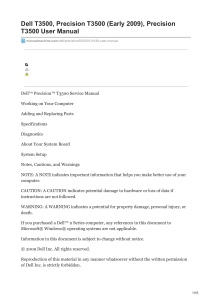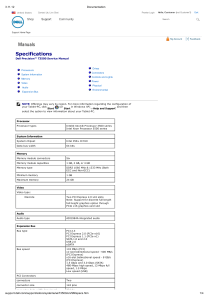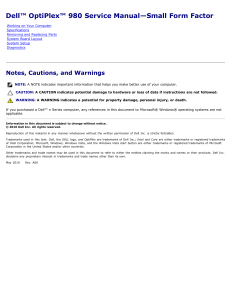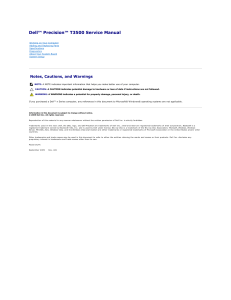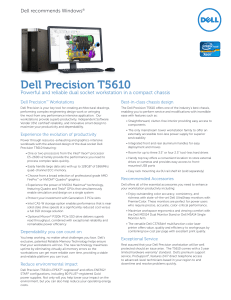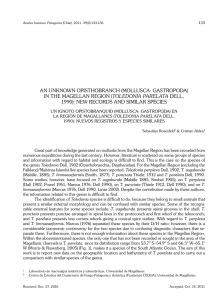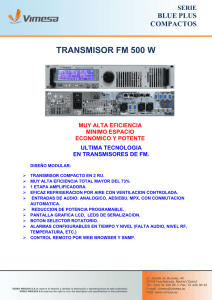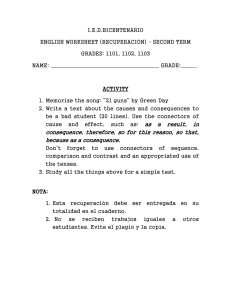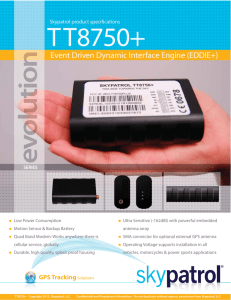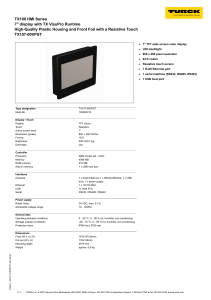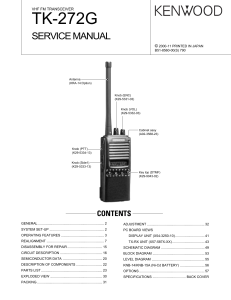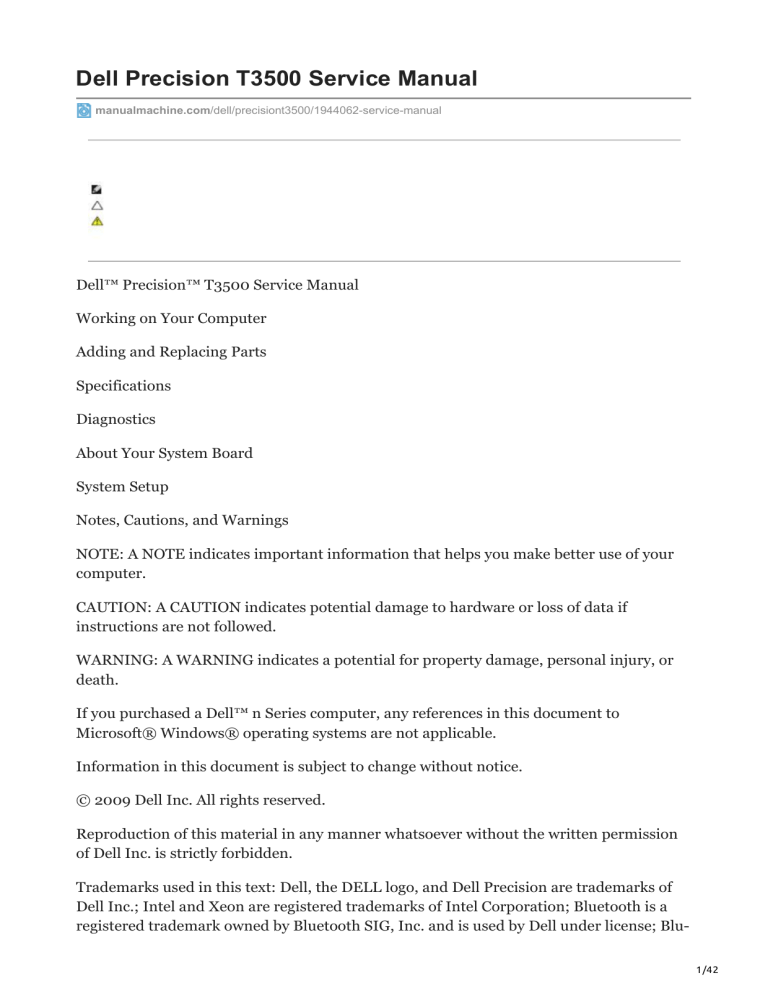
Dell Precision T3500 Service Manual manualmachine.com/dell/precisiont3500/1944062-service-manual Dell™ Precision™ T3500 Service Manual Working on Your Computer Adding and Replacing Parts Specifications Diagnostics About Your System Board System Setup Notes, Cautions, and Warnings NOTE: A NOTE indicates important information that helps you make better use of your computer. CAUTION: A CAUTION indicates potential damage to hardware or loss of data if instructions are not followed. WARNING: A WARNING indicates a potential for property damage, personal injury, or death. If you purchased a Dell™ n Series computer, any references in this document to Microsoft® Windows® operating systems are not applicable. Information in this document is subject to change without notice. © 2009 Dell Inc. All rights reserved. Reproduction of this material in any manner whatsoever without the written permission of Dell Inc. is strictly forbidden. Trademarks used in this text: Dell, the DELL logo, and Dell Precision are trademarks of Dell Inc.; Intel and Xeon are registered trademarks of Intel Corporation; Bluetooth is a registered trademark owned by Bluetooth SIG, Inc. and is used by Dell under license; Blu1/42 ray Disc is a trademark of the Blu-ray Disc Association; Microsoft, Windows, Windows Server, MS-DOS, Aero, Windows Vista. and the Windows Vista start button are either trademarks or registered trademarks of Microsoft Corporation in the United States and/or other countries. Other trademarks and trade names may be used in this document to refer to either the entities claiming the marks and names or their products. Dell Inc. disclaims any proprietary interest in trademarks and trade names other than its own. Model DCTA September 2009 Rev. A01 About Your System Board Dell Precision™ T3500 Service Manual 2/42 Password Enable Jumper NVRAM Reset Jumper System Board Schematic WARNING: Before working inside your computer, read the safety information that shipped with your computer. For additional safety best practices information, see the Regulatory Compliance Homepage at www.dell.com/regulatory_compliance. Your computer's system board offers two jumpers—a password enable jumper and a RTCRST (Real Time Clock Reset) jumper. Password Enable Jumper PSWD - Password enable. The system password will be cleared and disabled when the system is started with this jumper removed. Pins 1-2 shorted enables password NVRAM Reset Jumper RTCRST - Clears NVRAM. The NVRAM will be cleared when the jumper is closed (use the jumper from the password bridge). To properly clear; AC power must be applied (not necessarily turned on) to the system for about 10 seconds while the jumper is closed. Pins 1-2 shorted clears NVRAM The picture below shows the location of the configuration jumpers on the system board. NOTE: You can use the RTCRST jumper procedure above to attempt recovery from a No POST, No Video situation. System Board Schematic 3/42 1 PCI Card Slot (Slot 6) 2 PCI Card Slot (Slot 5) 3 PCIe x16 (Slot 4) 4 PCIe x4 (Slot 3) 5 PCIe x16 (Slot 2) 6 PCIe x4 (Slot 1) 7 Audio Front Panel (FP_AUDIO) 8 Internal USB (USB_1) 9 LPC_DEBUG 10 Processor Connector 11 CPU Power Connector (POWER_CPU) 12 Front Bezel Fan (FAN_Front) 13 Front Cage Fan (FAN_CCAG) 14 Memory Module (RAM) Connectors (DIMM_1-6) 15 Jumpers (PSWD & RTCRTS) 16 Battery Socket (CMOS Battery) 17 Internal USB Socket (for Flexbay Card Reader) 18 Main Power Connector 4/42 19 SATA Connectors (SATA_0-4) 20 HDD Fan (FAN_HDD) 21 Serial Connector (SERIAL2) 22 FDD Connector 23 Front Panel Connector (FRONTPANEL) 24 Chassis Intrusion Connector (INTRUDER) System Setup Dell Precision™ T3500 Service Manual POST Keystrokes Boot Menu Entering System Setup System Setup Navigation Keystrokes POST Keystrokes Your computer has several keystroke options available during the POST process at the Dell™ Logo screen. Keystroke Function Description 5/42 < F2> Enter System Setup Use System Setup to make changes to the userdefinable settings. < F12> or Enter Boot Menu One-time boot and diagnostics utility menu Network Boot Bypass the BIOS boot sequence and boot directly to the network <Ctrl><Alt> <F8> < F3> Boot Menu As with previous Dell Precision™ workstation platforms, your computer includes a onetime boot menu. This feature offers a quick and convenient method with which to bypass the System Setup-defined boot device order and boot directly to a specific device (e.g., floppy, CD-ROM, or hard drive). The boot menu enhancements introduced on previous platforms are as follows: •Easier access—Although the <Ctrl><Alt><F8> keystroke still exists and can be used to call up the menu, you can also simply press <F12> during system boot to access the menu. •Diagnostics options—The boot menu includes two diagnostic options, IDE Drive Diagnostics (90/90 Hard Drive Diagnostics) and Boot to the Utility Partition. Entering System Setup Press <F2> to enter System Setup and change the user-definable settings. If you have trouble entering System Setup using this key, press <F2> when the keyboard LEDs first flash. Follow the on-screen instructions to view and/or change any settings. On each screen, the system setup options are listed at the left. To the right of each option is the setting or value for that option. You can change settings that appear as white type on the screen. Options or values that you cannot change (because they are determined by your TabletPC) appear less bright. The upper-right corner of the screen displays help information for the currently highlighted option. The lower-right corner displays information about the computer. System setup key functions are listed across the bottom of the screen. 6/42 The system setup screens display the current setup information and settings for your computer, such as: •System configuration •Boot order •Boot (start-up) configuration •Basic device configuration settings •System security and hard drive password settings System Setup Navigation Keystrokes Use the following keystrokes to navigate the BIOS screens. Navigation Keystrokes Action Keystroke Expand and collapse field <Enter>, leftand right-arrow keys, or +/– Expand or collapse all fields <> Exit BIOS <Esc> — Remain in Setup, Save/Exit, Discard/Exit Change a setting Leftand right-arrow keys Select field to change <Enter> Cancel a modification <Esc> Reset defaults <Alt><F> or Load Defaults menu option NOTE: Depending on your computer and any installed devices, the items listed in this section may or may not appear. 7/42 Diagnostics Dell Precision™ T3500 Service Manual Dell Diagnostics Power Button Light Codes Diagnostic Light Codes Beep Codes Dell Diagnostics When to Use the Dell Diagnostics It is recommended that you print these procedures before you begin. NOTE: The Dell Diagnostics software works only on Dell computers. NOTE: The Drivers and Utilities disc is optional and may not ship with your computer. 8/42 Enter system setup (see Entering System Setup), review your computer's configuration information, and ensure that the device you want to test displays in System Setup and is active. Start the Dell Diagnostics from either your hard drive or from the Drivers and Utilities disc. Starting the Dell Diagnostics From Your Hard Drive 1.Turn on (or restart) your computer. 2.When the DELL logo appears, press <F12> immediately. NOTE: If you see a message stating that no diagnostics utility partition has been found, run the Dell Diagnostics from your Drivers and Utilities disc. If you wait too long and the operating system logo appears, continue to wait until you see the Microsoft® Windows® desktop. Then shut down your computer (see Turning Off Your Computer), and try again. 3.When the boot device list appears, highlight Boot to Utility Partition and press <Enter>. 4.When the Dell Diagnostics Main Menu appears, select the test that you want to run. Starting the Dell Diagnostics From the Drivers and Utilities Disc 1.Insert the Drivers and Utilities disc. 2.Shut down and restart the computer. When the DELL logo appears, press <F12> immediately. If you wait too long and the Windows logo appears, continue to wait until you see the Windows desktop. Then shut down your computer and try again. NOTE: The next steps change the boot sequence for one time only. On the next startup, the computer boots according to the devices specified in the system setup program. 3.When the boot device list appears, highlight Onboard or USB CD-ROM Drive and press <Enter>. 4.Select the Boot from CD-ROM option from the menu that appears and press <Enter>. 5.Type 1 to start the menu and press <Enter> to proceed. 6.Select Run the 32 Bit Dell Diagnostics from the numbered list. If multiple versions are listed, select the version appropriate for your computer. 7.When the Dell Diagnostics Main Menu appears, select the test you want to run. Dell Diagnostics Main Menu 9/42 1. After the Dell Diagnostics loads and the Main Menu screen appears, click the button for the option you want. Option Function Express Test Performs a quick test of devices. This test typically takes 10 to 20 minutes and requires no interaction on your part. Run Express Test first to increase the possibility of tracing the problem quickly. Extended Performs a thorough check of devices. This test typically takes 1 hour or more and requires you to answer questions periodically. Test Custom Test Tests a specific device. You can customize the tests you want to run. Symptom Lists the most common symptoms encountered and allows you to select a test based on the symptom of the problem you are having. Tree 2.If a problem is encountered during a test, a message appears with an error code and a description of the problem. Write down the error code and problem description and follow the instructions on the screen. 3. If you run a test from the Custom Test or Symptom Tree option, click the applicable tab described in the following table for more information. Tab Function Results Displays the results of the test and any error conditions encountered. Errors Displays error conditions encountered, error codes, and the problem description. 10/42 Help Describes the test and may indicate requirements for running the test. Configuration Displays your hardware configuration for the selected device. The Dell Diagnostics obtains configuration information for all devices from system setup, memory, and various internal tests, and it displays the information in the device list in the left pane of the screen. The device list may not display the names of all the components installed on your computer or all devices attached to your computer. Parameters Allows you to customize the test by changing the test settings. 4.When the tests are completed, if you are running the Dell Diagnostics from the Drivers and Utilities disc, remove the disc. 5.Close the test screen to return to the Main Menu screen. To exit the Dell Diagnostics and restart the computer, close the Main Menu screen. Power Button Light Codes The power LED located in the power button on the front of the computer illuminates and blinks or remains solid to indicate five different states: •No light—System is in the off state (S5, or mechanical (AC power not applied) OFF). •Solid Amber—System fault, but Power Supply is good—normal operating state (S0 ). •Blinking Amber—System fault error condition including Power Supply (only +5VSB working), Vreg failure, missing or bad CPU. •Blinking Green—System is in power saving states S1, S3 or S4. (Blink rate is 1Hz). No fault/error condition. •Solid Green—System is fully functional and is in S0 (ON) state. Diagnostic Light Codes Four (4) single color lights are incorporated on the front control panel to serve as a diagnostic aid for troubleshooting systems exhibiting No Post/No Video symptoms. The lights do not report runtime errors. 11/42 Diagnostic LED Patterns LED pattern (1234) LED Description State description 1 - Off 2 - Off BIOS checksum failure detected; system is in recovery mode. 3 - Off 4 - On 1 - Off 2 - Off Possible processor failure. 3 - On 4 - Off 1 - Off 2 - Off Memory failure. 3 - On 4 - On 1 - Off 2 - On Possible expansion card failure. 3 - Off 4 Off 12/42 4 - Off 1 - Off 2 - On Possible video failure. 3 - Off 4 - On 1 - Off 2 - On Diskette drive or hard drive failure. 3 - On 4 - Off 1 - Off 2 - On Possible USB failure. 3 - On 4 - On 1 - On 2 - Off No memory modules detected. 3 - Off 4 - Off 1 - On 2 Off 13/42 2 - Off System board failure. 3 - Off 4 - On 1 - On 2 - Off Memory configuration error. 3 - On 4 - Off 14/42 1 - On 2 - Off Possible system board resource and/or system board hardware failure. 3 - On 4 - On 15/42 1 - On 2 - On Possible system resource configuration error. 3 - Off 4 - Off 1 - On 2 - On Other failure. 3 - On 4 - Off 1 - On 2 - On End of POST - Hand off to boot. 3 - On 4 - On 1 - Off 2 - Off The system is in a normal operating condition after POST. 3 - Off 4 - Off Beep Codes When errors occur during a boot routine that cannot be reported on the monitor, the computer may emit a beep code that identifies the problem. The beep code is a pattern of sounds: for example, one beep followed by a second beep, then followed by a burst of three beeps (code 1-1-3) means that the computer was unable to read the data in nonvolatile random-access memory (NVRAM). If the system loses power and beeps constantly when you turn it back on, the BIOS is probably corrupted. System Beep Codes 16/42 Beep Description Code Beep Description Code 1-1-2 CPU register test in progress 2-4-3 1st 64 K RAM chip or data line failure - bit E 1-1-3 CMOS read/write test in progress or failure 2-4-4 1st 64 K RAM chip or data line failure - bit F 1-1-4 BIOS ROM checksum in progress or failure 3-1-1 Slave DMA register test in progress or failure 1-2-1 Timer Test in progress or failure 3-1-2 Master DMA register test in progress or failure 1-2-2 DMA initialization in progress or failure 3-1-3 Master IMR test in progress or failure 1-2-3 DMA page register read/write test in 3-1-4 Slave IMR test in progress or failure progress or failure 1-3-1 RAM refresh verification in progress or failure 3-2-2 Interrupt vector loading in progress 1-3-2 1st 64 K RAM test in progress or failure 3-2-4 Keyboard controller test in progress or failure 1-3-3 1st 64 K RAM chip or data line failure (multi 3-3-1 CMOS power fail and checksum test in bit) progress 17/42 1-3-4 1st 64 K RAM odd/even logic failure 3-3-2 CMOS Config info validation in progress 1-4-1 1st 64 K RAM address line failure 3-3-3 RTC/Keyboard controller not found 1-4-2 1st 64 K RAM parity test in progress or failure 3-3-4 Screen memory test in progress or failure 1-4-3 Fail-safe timer test in progress 3-4-1 Screen initialization test in progress or failure 1-4-4 Software NMI port test in progress 3-4-2 Screen retrace tests test in progress or failure 2-1-1 1st 64 K RAM chip or data line failure - bit 0 3-4-3 Search for video ROM in progress 2-1-2 1st 64 K RAM chip or data line failure - bit 1 4-2-1 Timer tick interrupt test in progress or failure 2-1-3 1st 64 K RAM chip or data line failure - bit 2 4-2-2 Shutdown test in progress or failure 2-1-4 1st 64 K RAM chip or data line failure - bit 3 4-2-3 Gate A20 failure 2-2-1 1st 64 K RAM chip or data line failure - bit 4 4-2-4 Unexpected interrupt in Protected Mode 2-2-2 1st 64 K RAM chip or data line failure - bit 5 4-3-1 RAM test in progress or failure above address 0FFFFh 18/42 2-2-3 1st 64 K RAM chip or data line failure - bit 6 4-3-2 No memory in Bank 0 2-2-4 1st 64 K RAM chip or data line failure - bit 7 4-3-3 Interval Timer Channel 2 test in progress or failure 2-3-1 1st 64 K RAM chip or data line failure - bit 8 4-3-4 Time-Of-Day Clock test in progress or failure 2-3-2 1st 64 K RAM chip or data line failure - bit 9 4-4-1 Super I/O chip failure 2-3-3 1st 64 K RAM chip or data line failure - bit A 4-4-4 Cache test failure 2-3-4 1st 64 K RAM chip or data line failure - bit B 2-4-1 1st 64 K RAM chip or data line failure - bit C 2-4-2 1st 64 K RAM chip or data line failure - bit D Adding and Replacing Parts Dell Precision™ T3500 Service Manual Cover I/O Panel Front Bezel Power Supply Hard Drive Drives Bezel 19/42 Floppy Drive Optical Drive Memory Card Reader Memory Memory Shroud Expansion Card Battery Chassis Intrusion Switch Video Card Fan Assembly Heat Sink and Processor Systemboard I/O Data Cable Specifications Dell Precision™ T3500 Service Manual Drives Processors Connectors System Information Controls and Lights Memory Power Video Physical Audio Environmental Expansion Bus NOTE: Offerings may vary by region. For more information regarding the configuration of 20/42 your TabletPC, click Start (or Start in Windows XP)® Help and Support, and then select the option to view information about your Tablet-PC. Processor Processor types Intel® Xeon® Processor 3500 series Intel Xeon Processor 5500 series System Information System chipset Intel X58+ ICH10 Data bus width 64 bits Memory Memory module connectors Six Memory module capacities 1 GB, 2 GB, or 4 GB 21/42 Memory type DDR3 1066 MHz & 1333 MHz (Both ECC and NonECC) Minimum memory 1 GB Maximum memory 24 GB Video Video type: Discrete Two PCI Express 2.0 x16 slots Note: Support for discrete full length full height graphics option through PCIe x16 graphics card slot Audio Audio type ADI1984A integrated audio Expansion Bus Bus type PCI 2.3 22/42 PCI Express 2.0 (PCIe-x16) PCI Express 1.1 (PCIe-x1) SATA 1.0 and 2.0 USB 2.0 eSATA Bus speed 133 MB/s (PCI) x1-slot bidirectional speed - 500 MB/s (PCI Express) x16-slot bidirectional speed - 8 GB/s (PCI Express) 1.5 Gbps and 3.0 Gbps (SATA) 480-Mbps high speed, 12-Mbps full speed, 1.2-Mbps Low speed (USB) PCI Connectors connectors Two connector size 124 pins 23/42 connector data width (maximum) 32 bits PCI Express x8 connector Two connector size 98 pins PCI Express x16 connector Two connector size 164 pins Drives Externally accessible One 3.5-inch drive bay (FlexBay), Two 5.25-inch drive bays Internally accessible Two 3.5-inch SATA drive bays Note: The platform can accommodate third and fourth 24/42 3.5-inch hard drives in the flex bay or the optical drive bay. (4 HDD support is limited to SATA only & tower orientation only, SAS is limited to 3 HDD) Available devices 3.5-inch SATA hard drives SATA DVD, SATA CD-RW/DVD Combo, SATA DVD+/-RW, SATA BD Combo (Blu-Ray playback only), SATA Blu-ray R/W One 3.5-inch USB media card reader with Bluetooth® Internal USB floppy drive Connectors External connectors: Video (Depending on video card) DVI connector Display port Network adapter RJ-45 connector 25/42 USB USB 2.0 compliant, support 2.0 A sustained charge to power external USB devices Two internal connectors Two in front Six at the back Audio Two rear connectors for line-in and line-out Two front-panel connectors for headphones and microphone Serial One 9-pin connectors; 16550C-compatible PS/2 Two 6-pin mini-DIN connector IEEE 1394a One front-panel 6-pin connector (with optional card) System board connectors: Serial ATA Seven 7-pin connectors Internal USB device One 10-pin connector Processor fan One 4-pin connector Chassis fan One 3-pin connector 26/42 HDD cage fan One 3-pin connector PCI 2.3 Two 124-pin connectors PCI Express x8 Two 98-pin connector PCI Express x16 Two 164-pin connector Front panel control (USB included) One 40-pin connector Front panel audio HDA header One 10-pin connector Processor One 1366-pin connector Memory Six 240-pin connectors Processor Power One 8-pin connector Power One 24-pin connector Controls and Lights Front of the computer: Power button Push button 27/42 Amber light . Solid amber indicates a problem with an Power light installed device; blinking amber indicates an internal power problem. Green light . Blinking green in sleep state; solid green for power-on state. Drive activity light Green light . A blinking green light indicates the computer is reading data from or writing data to the SATA hard drive or CD/DVD. Network link light Green light . Solid green indicates a connection to an active network Off (no light) . System is not connected to a network Back of the computer: Green . A good connection at 10Mbs exists between the network and the computer. Link integrity light (on integrated Orange . A good connection at 100Mbs exists between 28/42 the network and the computer. network adapter) Yellow . A good connection at 1000Mbs exists between the network and the computer. Off . The computer is not detecting a physical connection to the network. Network activity light (on integrated network adapter) Yellow blinking light Power DC power supply: Wattage 525 W Maximum heat dissipation (MHD) 1194 BTU/hr Voltage 115/230 VAC, 50/60 Hz, 6.0/3.0 A Coin-cell battery 3 V CR2032 lithium coin cell Physical 29/42 Height 44.8 cm (17.6 inches) Width 17.2 cm (6.8 inches) Depth 46.8 cm (18.4 inches) Weight 17.3 kg (38.0 lb) Environmental Temperature range: Operating 10° to 35°C (50° to 95°F) Storage -40° to 65°C (-40° to 149°F) Relative humidity (maximum): 20% to 80% (noncondensing) Maximum vibration (using a randomvibration spectrum that simulates user environment): Operating 5 to 350 Hz at 0.0002 G²/Hz Storage 5 to 500 Hz at 0.001 to 0.01 G²/Hz Maximum shock (measured with hard drive in head- 30/42 parked position and a 2-ms half-sine pulse): Operating 40 G +/- 5% with pulse duration of 2 msec +/- 10% (equivalent to 51 cm/sec [20 in/sec]) Storage 105 G +/- 5% with pulse duration of 2 msec +/- 10% (equivalent to 127 cm/sec [50 in/sec]) Altitude (maximum): Operating -15.2 to 3048 m (-50 to 10,000 ft) Storage -15.2 to 10,668 m (-50 to 35,000 ft) Airborne contaminant level G2 or lower as defined by ISA-S71.04-1985 31/42 Battery Dell Precision™ T3500 Service Manual WARNING: Before working inside your computer, read the safety information that shipped with your computer. For additional safety best practices information, see the Regulatory Compliance Homepage at www.dell.com/regulatory_compliance. Removing the Battery 1.Follow the procedures in Before Working Inside Your Computer. 32/42 2.Remove the computer cover. 3.Lift the hard drive tray. NOTE: The memory module shroud has been removed to increase visibility to the following procedure. 2. Use a small screw driver or a scribe to push the coin-cell release tab. 3. Remove the coin-cell battery from the computer. Cover Dell Precision™ T3500 Service Manual WARNING: Before working inside your computer, read the safety information that shipped with your computer. For additional safety best practices information, see the Regulatory Compliance Homepage at www.dell.com/regulatory_compliance. Removing the Cover 33/42 1. Follow the procedures in Before Working Inside Your Computer. 2. Pull the cover release latch toward the back of the computer. 34/42 3. Pivot the cover away from the computer and then remove the cover. Drives Bezel Dell Precision™ T3500 Service Manual 35/42 WARNING: Before working inside your computer, read the safety information that shipped with your computer. For additional safety best practices information, see the Regulatory Compliance Homepage at www.dell.com/regulatory_compliance. Removing Drives Bezel 1.Follow the procedures in Before Working Inside Your Computer. 2.Remove the computer cover. 3.Remove the front bezel. 4. Push the sliding plate lever down to release the drives bezel. 5. Tilt the drives bezel away from the front of the computer. 6. Remove the drives bezel from the computer. 36/42 37/42 Front Bezel Dell Precision™ T3500 Service Manual WARNING: Before working inside your computer, read the safety information that shipped with your computer. For additional safety best practices information, see the Regulatory Compliance Homepage at www.dell.com/regulatory_compliance. Removing the Front Bezel 1.Follow the procedures in Before Working Inside Your Computer. 2.Remove the computer cover. 4. While pressing the release tab down (1) slide the bezel toward the top of the computer (2). 38/42 39/42 5. Remove the bezel from the front of the computer. Front Fan Assembly Dell Precision™ T3500 Service Manual 40/42 WARNING: Before working inside your computer, read the safety information that shipped with your computer. For additional safety best practices information, see the Regulatory Compliance Homepage at www.dell.com/regulatory_compliance. Removing the Front Fan Assembly 1.Follow the procedures in Before Working Inside Your Computer. 2.Remove the computer cover. 3.Lift the hard drive tray: a. Push and hold the blue release tab toward the bottom of the computer. b. Raise the hard drive tray on its hinges. 4. Remove the memory module shroud. 5. Disconnect the two fan cables from the system board. 41/42 42/42
